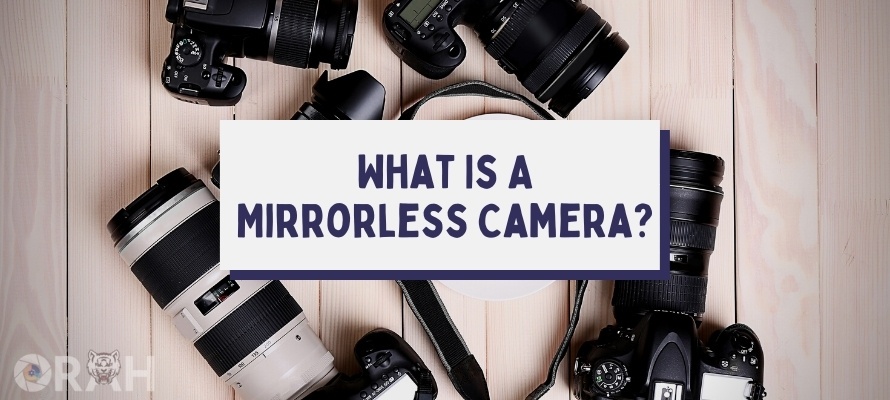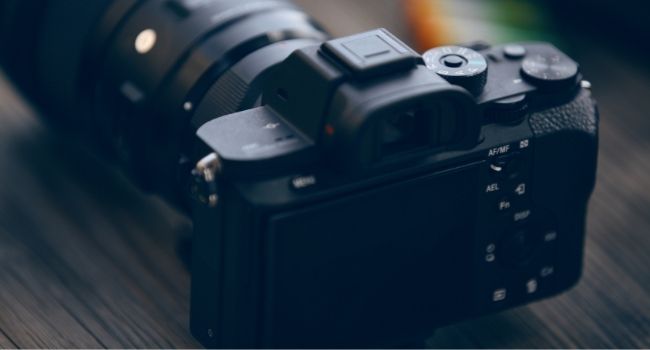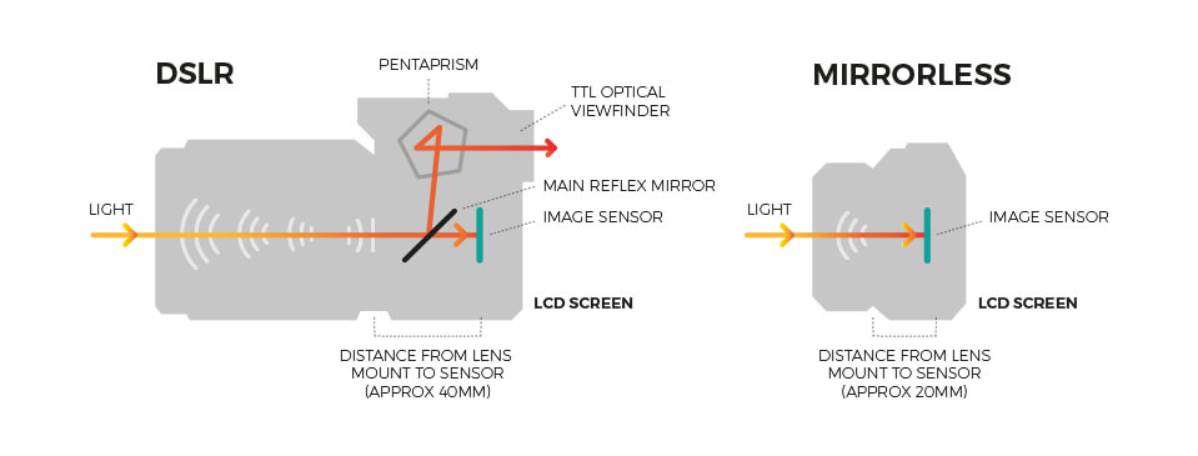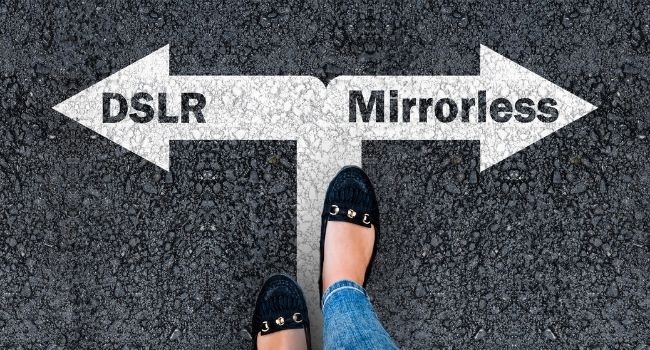
Back in the October of 2008, something strange happened. Panasonic took the stage and announced the Panasonic Lumix DMC-G1, while the camera itself looked like any other camera, but there was a difference here.
This was a mirrorless camera, and a lot of people claim that it was the first commercially marketed mirrorless camera.
However, at the time of its launch, not many people, especially the traditional and hardcore DSLR users, were looking to buy this camera because they were more than happy with their DSLRs, and to be honest, DSLRs of that era were also way ahead of mirrorless cameras.
However, the press did put their faith in mirrorless cameras, along with many other photographers, and today, we see mirrorless cameras dominating the market.
But what is a mirrorless camera, you might ask? Good thing I am here to educate you all about this camera, so you get to know what you are getting into in case you want to buy one.
What Is A Mirrorless Camera?
Honestly, a lot of people unnecessarily complicated this entire situation, but in reality, mirrorless cameras are not at all complicated.
They are a lot like your standard DSLR cameras, but the name gives it away. Unlike a conventional DSLR camera, a mirrorless camera does not have a mirror.
The lack of a mirror makes these cameras a lot lighter, but there are some other changes here too.
Since the mirror is gone, you are not getting access to the optical viewfinder. Instead, that is replaced with a small electronic viewfinder with incredibly high resolution and good brightness.
The good thing about an EVF or an electronic viewfinder is that it allows you to see the changes in the picture in real-time.

For instance, if you are framing a shot and adjusting the ISO, aperture, shutter speed, or the exposure of the photo, whatever the changes are going to be, will be displayed in real-time. This helps in composing the shots a lot easier.
Due to the lack of mirrors, mirrorless cameras also have their sensors prone to dust because the moment you take off the lens, instead of the mirror being flipped down, you see the sensor. So, whatever dust that might fall on the mirror falls straight on the sensor.
Modern-day mirrorless camera systems have become a lot more popular, and they are on their way to slowly phase out the DSLR cameras that we used to love so much.
How Do Mirrorless Cameras Work?
This is again one of the most sought-after questions because some of us want to know about the workings of mirrorless cameras, and honestly, it is not that hard to get started with understanding how these cameras work. Since 2008, mirrorless cameras have been working on the same principle.
However, the core technology has improved drastically; things like sensors and EVF have come a long way, to the point that it is hard imagining a life without a good mirrorless system.
With that said, if you are wondering how a mirrorless camera works, here’s an example in the image.

Well, As I have already said that these cameras do not have any mirror to guide the light to the viewfinder and give us an understanding of what we are looking for. Instead, the light passes through the lens and hits the sensor directly.
So, if there is no mirror, this means that there is no optical viewfinder. How do you get to see what you are shooting?
Well, this is where the electronic viewfinder comes into place.
When the light hits the sensor, it displays the scene straight into the electronic viewfinder. From there, you can make all manners of adjustments to your photos and that too, without any issues that might be there.
I do understand that this might not be something that everyone understands at first, but mirrorless cameras are no longer as complicated to understand because we are 13 years into the technology, and things have stayed the same, but the excess of information has only evolved.
Rest assured, a mirrorless camera is a great way to get started if you are in the market looking for something new and improved.
Related article: How To Attach Your Camera Strap The Right Way
What Are The Benefits Of Using A Mirrorless Camera?
Now that you have read through most of what I have shared about mirrorless cameras, I am finally bringing you down to advantages.
A lot of photographers who are either looking to upgrade or buy their first camera often ask about the advantages of mirrorless cameras as opposed to DSLR cameras, and as is their right.
After all, if I were to spend upwards of $1,500 on a camera, I would also want to know about mirrorless cameras and how they work.
But whatever the case might be, I am here to fix that for you as this is going to allow you to have a better understanding of how mirrorless cameras are better and superior.
1- Great Autofocusing
While I admit that in the start, mirrorless cameras suffered from autofocusing issues, and they were not as good, but over the past couple of years, the sensors and autofocusing technology has evolved to a point that mirrorless cameras have become almost unbeatable in the way they work.
If you are looking for an example, just look at how far Sony has come with their autofocusing in the Sony A7 series. The cameras are autofocusing beasts. But do not worry, other manufacturers such as Canon and Nikon have not been resting either.
2- Weight and Size
Another massive benefit that a mirrorless camera brings to the table is the fact that it is a lot lighter than some of the other available options.
For instance, a mirrorless camera lacks a mirror. This alone makes the camera not only lighter to carry around, but it also gets rid of the excess size that you might be worried about.
So, if you are someone who likes to have a lighter and smaller camera for added mobility, this is the way to go.
3- Real-Time Previews
Have you ever taken a picture using your DSLR that was perfectly composed with great lighting but came out looking the opposite?
That is because what we see through the optical viewfinder is how the scene looks. Regardless of the adjustments you make to the exposure triangle, nothing will change until the picture is taken and processed.
However, with mirrorless cameras, all the changes are displayed in real-time through the EVF, and it makes everything a lot easier when you are trying to photograph something.
Especially in scenes where you cannot be bothered to retake the same shot again and again.
Related article: What Does A Lens Hood Do?
4- Great Lowlight Performance
Granted, in the start, mirrorless cameras used to suffer as far as the overall performance was concerned.
Especially when you are talking about lowlight performance, but that changed as the technology progressed, and modern-day mirrorless cameras are absolute beasts when you are talking lowlight photography.
Just take the Sony A7SIII, for example. It is one of the cameras everyone recommends whenever you are looking to go with lowlight photography or videography and the best part is that you do not have to worry much about anything else.
5- Great Autofocusing in the Videos
I understand that this might not be on everyone’s radar, but just in case you are looking to buy a mirrorless camera and shooting videos is one of the things that you are looking forward to doing.
Getting a good mirrorless camera is always a good way to get started as it will help you achieve everything you want to achieve.
Especially with the modern mirrorless cameras and how they have different levels of autofocusing ranging from eye autofocus to even animal eye autofocus. Things have changed almost entirely for the industry ever since these technologies were announced.
DSLR Vs Mirrorless Cameras
This is something that reaches the table now and then. People are generally interested in knowing that when they do get their hands on their first camera, should they be going for a mirrorless or a DSLR camera.
Again, the differences between both cameras might seem like they are not a lot, but in reality, these cameras are inherently different, even though the purpose is the same.
The biggest difference between a DSLR and a mirrorless camera is that the latter does not come with a mirror and as I have mentioned before, this only makes the camera a lot lighter to carry and a lot easier to put somewhere. Thanks to the reduced size.

In addition to that, since the mirrorless camera no longer has a mirror, the means that the light does not fall onto the mirror.
Instead, it passes through the lens, and goes straight to the sensor, and is displayed in the EVF. An EVF is an electronic viewfinder, essentially a really small and bright screen that is where an optical viewfinder would be.
Because mirrorless cameras are using 2 screens, the overall battery life gets impacted. However, almost all the camera manufacturers have been working tirelessly to ensure that the battery life difference is being taken care of.
The gap is slowly being closed down, and mirrorless cameras have come a long, long way in terms of the battery life
For anyone who is wondering, these are some of the most common comparison points between both cameras. However, in case I have not said it before. Mirrorless cameras are becoming the norm, and soon, we would not be seeing DSLR cameras being made.
Electronic Vs Optical Viewfinders
While I am at it, I would also like to shed light on the optical and electronic viewfinders.
After all, when you are comparing a mirrorless and a DSLR camera, the viewfinders are definitely among the biggest differentiators, and the best part is that despite serving the same purpose, they are inherently different in the way they work.
An optical viewfinder relies on the light that hits the mirror and then reaches the optical viewfinder or our eyes.
This means that what the lens is seeing what you will see, and if you decide to make any changes to the camera settings as in the aperture, the shutter speed, or even the ISO, there will be no change displayed as the image is still not being processed, and you are just seeing what the camera is seeing.
However, since there is no mirror, there is no light hitting the mirror. Instead, the light hits the sensor, and that image is then displayed on the electronic viewfinder.
Now, in case you want to go ahead and make changes to those settings such as the ISO, aperture, or shutter speed, however they will affect the image is going to be displayed on the electronic viewfinder in real-time.
This small change makes a world of difference when you are taking a picture because it just makes taking pictures a lot easier. Rest assured, electronic viewfinders are the future, and you cannot live without them, to be honest.
Auto Focus, Image Quality & Battery Life
We are getting closer to the end of this article, and we have to discuss some of the important aspects that a lot of people are going to focus on when they are buying a new camera.
I am not saying that mirrorless cameras were free of faults; there were a lot of issues with these cameras, to be honest. The start was slow, and many of us even thought that these cameras would not make it far.
However, that has changed. Speaking of autofocus, mirrorless cameras are now unrivaled in terms of the consistency and precision of autofocusing.

Especially the more modern Sony cameras, whether you are buying a cropped sensor or a full-frame sensor, you are getting inherently superior autofocus, and it is also a lot faster with minimum focus hunting.
Secondly, image quality is another factor where mirrorless cameras are winning. Sure, they suffered in the start, but the overall gap has been closed ever since, and you are no longer going to run into any issues as far as the overall experience is concerned.
Last but not the least, the battery life has always been a massive question mark for a lot of people because people have been wondering if it is going to be good or not, and well, that is not a problem for anyone anymore.
Yes, mirrorless cameras started with having the worst battery that anyone can imagine. However, things have changed a lot in the modern-day and age since these cameras have become a lot more accessible.
The battery gap that used to be there is slowly closing, and you are now getting something better than before, and soon, mirrorless cameras will surpass that as well.
Related article: What Is High-Speed Sync Flash? – Why To Use It?
The Performance & Overall Features
Of course, if you are dropping so much money on a camera, you would want it to have a good performance because without that, you are not going that far.
Thankfully, I have had a good experience with both types of cameras. So, I can help you here as far as the overall experience is concerned.
If you are looking for the performance, I have to admit that the earlier mirrorless cameras were not as good. The autofocus was all over the place, the image quality was a mess, and finding lenses was a difficult experience.
However, modern mirrorless cameras do not have to go through any of that. They are highly adaptable, and the best part is that these cameras are available in several variants and lenses for these corresponding variants are also available.
You can start from micro-four-thirds and go for something like a cropped sensor. The best being the full-frame sensor. The point is that if you are looking for something genuinely good.
The options are going to be there, and you can choose the one that you want without really having to stress much. As far as the features are concerned, both DSLR and mirrorless cameras have more or less the same feature set, to be honest.
Considering how they are inherently the same cameras on principle with few changes that make them different. So, you are not looking at different sets of features that one might have over the other.
The reason why mirrorless cameras are preferred is that they are modern, and the technology is relatively new. Not just that, the manufacturers have realized this dominance and their focus is largely on making good mirrorless cameras.
Wrap-Up:
I can understand that if you are new to photography, things might be difficult for you when it comes to deciding which camera you should be getting.
A lot of the time, things like that make very little difference to some photographers. But considering how popular mirrorless cameras have become, it is better that you are looking at all the modern offerings available.
With all the cameras in the market, things can be complicated for you. The purpose of this article was to help you decide which camera would be best for you.
I took my time with mirrorless cameras and consolidated them into this article, so you have an easier time choosing what you are looking to go for. Rest assured, once you are sure of what you want to go with, you will have no issues whatsoever.
Frequently Asked Questions (FAQs)
Q1- Why are mirrorless cameras better?
Answer: There are a lot of reasons why mirrorless cameras are better, to be honest. You are getting something that is lighter in weight, smaller, easier to carry.
You are also getting something that has a lot of features, allows for real-time preview, and so many more features.
Q2- What is the point of a mirrorless camera?
Answer: The point of mirrorless cameras is to increase the convenience for photographers and videographers.
High-end DSLR cameras are unnecessarily heavier, and it is better that you are focusing on changing that by delivering something that is lighter in weight and works well, too. This is where mirrorless cameras come into play.
Q3- What are the disadvantages of a mirrorless camera?
Answer: Mirrorless cameras used to be a lot more limited as compared to DSLR cameras. However, over the past couple of years, the differences have almost vanished to the point that DSLR cameras are slowly becoming obsolete.
The biggest disadvantage of a mirrorless camera was the poor battery life, but even that is slowly changing, and you are now getting something that is a lot better.
Q4- Will DSLR be replaced by mirrorless?
Answer: Yes, the transition is already having as mirrorless cameras are gradually increasing in terms of the market share and are becoming better than the DSLR cameras. It won’t be long before mirrorless cameras surpass DSLR cameras.
Q5- Is Canon going all mirrorless?
Answer: Not just Canon, but slowly, all major manufacturers and even the smaller ones are shifting to mirrorless cameras.
It is not just because of the insane demand for these cameras but also because of how popular these cameras are in the modern-day market, and people want the best.
Q6- Are mirrorless cameras good for wildlife photography?
Answer: Yes, mirrorless cameras are excellent for not just wildlife photography but all sorts of subject matters. You just have to know what camera and lens combination you have to use, and you are good to go.
Q7- Are mirrorless cameras better in low light?
Answer: Yes, mirrorless cameras are inherently better in low light, and the fact that you can preview the image beforehand is also a huge benefit.